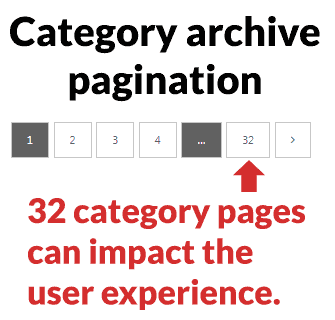Pagination is the common and useful way to order category pages that contain links to articles or product pages. Pagination is a good thing. But in some situations it can lead to an excessively deep category archive which can impact indexing and ranking.
Pagination
Pagination in this context relates to linking a topic category archive to another one in a sequence, usually ordered by date. So if you have 100 articles and each category archive contains summaries and links to twenty articles, it will take five category archive pages to contain them all. The pagination consists of five pages.
Related: SEO-Friendly Pagination: A Complete Best Practices Guide
What is Excessive Pagination?
Pagination in the context of web publishing relates to the number of pages that accumulate in an archive of web pages. It happens when you have so many products in a category or pages in a category archive of articles that the shopping cart software or Content Management System (CMS) create a sequence of pages to contain them all.
Normally this isn’t a problem. It becomes problematic when a site visitor must click scores and hundreds of links to what a site visitor may perceive as seemingly infinite number of category pages. It can become an inefficient way to archive web pages.
How Pagination Affects Ranking
It becomes difficult to reach an individual article or product page when there are too many category pages to click through to find it.
What happens is that web pages become increasingly distant from the home page and essentially buried as more articles are added to the category.
This dampening effect can of course be counteracted with direct links to the page. A page that accrues direct links is considered authoritative.
The problem of excessively deep pagination can creep up over the course of months and years (depending on content production). The negative effects can go unnoticed until the site traffic begins slowly trending downward.
The more time passes the deeper an article is buried within the category archive. Failing to address excess pagination can lead to a decline in search traffic.
Flat Site Architecture
A popular way to deal with this issue is to create a flat site architecture. A flat site architecture is about creating so many links from the home page to second and third level web pages that every single page in the site is one to three clicks away from the home page.
A downside to that strategy is that there is no way to theme a site into different categories in order to give sections of a site a meaningful interlinking between pages.
For example, on a personal injury site a page about Car Injury Attorney might feature dozens of links to other pages about completely different topics like slip and fall injuries.
Outbound links can communicate what that page linking out is about. Ideally a page about Car Injury Attorney will have outbound links related to that topic that reinforce that topic instead of making the topic of a web page opaque and less specific.
A flat site architecture is not commonly recommended nor is it widely regarded as a best practice. Flat site architecture is a fringe practice.
How Site Structure Becomes Corrupted
What usually happens is that a publisher begins with an initial set of categories then publishes within those categories.
Over the months and years the time arrives that the number of pages within each category becomes difficult to navigate.
That’s when the pagination site structure creeps in.

This results in categories containing dozens or hundreds of category archive pages. That’s a pagination style of site structure.
That style form of site architecture forces the user to click through pages about a category but not necessarily about the subtopic of that category they are interested in.
As an example, let’s say a lifestyle site has a section for travel. At some point the publisher must review a list of all the articles and understand:
- Which article topics are most popular with site visitors?
- Which article topics have the most articles devoted to them?
The next step is to take those topics and break them out into their own subcategories. Doing that helps users (and Google) to reach the articles they are looking for more easily.
In my opinion based on my experience it can also help search engines better understand what an article is about in terms of what the topic of the article is.
There’s a difference between signaling that an article is about Travel and signaling that the article is about Travel to Austin, Texas.
By dividing a category into subtopics a publisher can surface more content and help Google better understand what the article is about.
This may not be a solution for everyone, no solution is. But it’s good to be aware of it and be able to deploy it when it is ideal to do so.
Related: How to Improve Your Website Navigation: 7 Essential Best Practices
John Mueller Commented About Site Architecture
Someone recently tweeted a question to Google Webmaster Trends Analyst John Mueller:
“Dare I ask this but tips on handling pagination for a blog (not e-commerce, so no product pages) with over 1,000 pages? Let’s just say it’s been around for 8 years and SEO wasn’t a major factor for most of that.”
John Mueller responded:
“Use categories or tags to cross link so that you have a handful paginated pages per type, from where you link to the blog posts. Keep a good & balanced hierarchy, not too flat, not too deep.”
In a Webmaster Hangout, Mueller said this about site architecture:
“…we’ll see the home page is really important, things linked from the home page are generally pretty important as well.
And then… as it moves away from the home page we’ll think probably this is less critical.”
That pages linked directly from the home page are important is fairly well known but it’s worth repeating. In a well organized website the major category pages and any other important pages are going to be linked from the home page.”
Takeaway
If site traffic and ranking is slowly taking a dip, consider adding the pagination issue to the checklist of things to review. I’ve had great success increasing the number of pages indexed and ranked by Google by splitting a category into subcategories for sites experiencing this specific problem.





